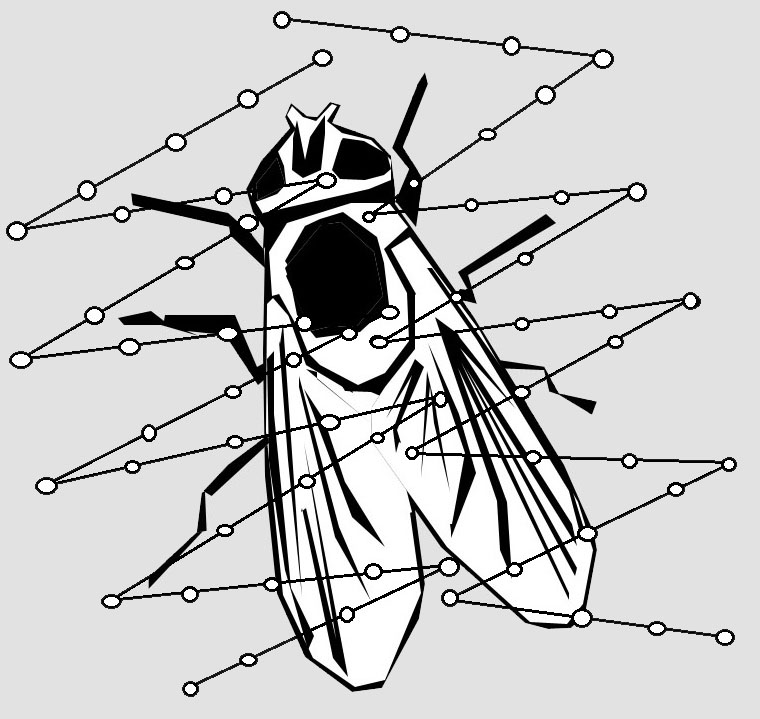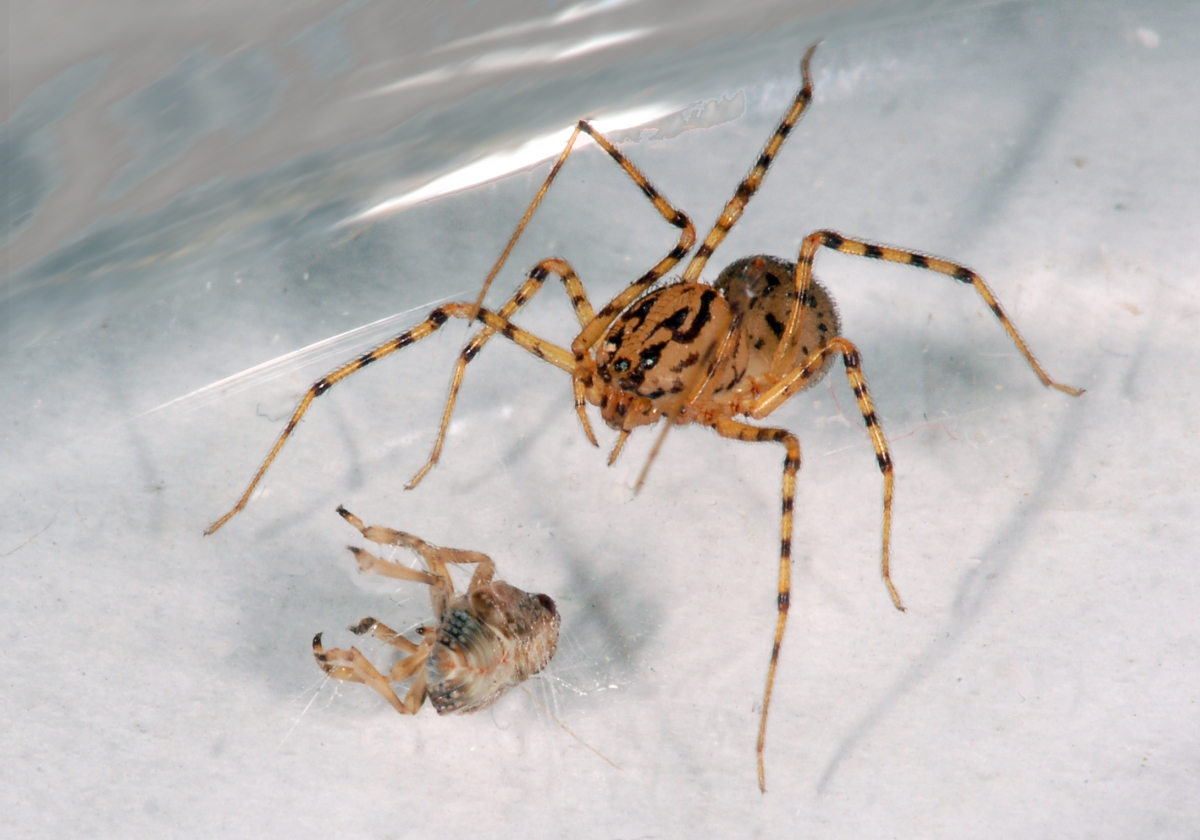Scytodes on:
[Wikipedia]
[Google]
[Amazon]
''Scytodes'' is a genus of spitting spiders that occur all around the world, with the most widely distributed species being ''
 The spitting from which its common name derives is used as a method of trapping prey or escaping predators. Scytodes glue is made in a large gland in the
The spitting from which its common name derives is used as a method of trapping prey or escaping predators. Scytodes glue is made in a large gland in the 



Scytodes thoracica
''Scytodes thoracica'' is a spitting spider, so called because it spits a venomous sticky silken substance over its prey. Its size ranges between . The carapace is unusual in sloping upwards towards its rear end, whereas the abdomen slopes downw ...
'', originally having a palearctic
The Palearctic or Palaearctic is a biogeographic realm of the Earth, the largest of eight. Confined almost entirely to the Eastern Hemisphere, it stretches across Europe and Asia, north of the foothills of the Himalayas, and North Africa.
Th ...
distribution but has since been introduced to North America, Argentina, India, Australia, Asia and New Zealand. Individuals of the genus are generally characterized by their predominant pale yellow coloration and black markings on their cephalothorax
The cephalothorax, also called prosoma in some groups, is a tagma of various arthropods, comprising the head and the thorax fused together, as distinct from the abdomen behind. (The terms ''prosoma'' and ''opisthosoma'' are equivalent to ''cepha ...
compounded with long, thin hairless legs with black bands.
Taxonomy
The first species of the genus was first described byPierre André Latreille
Pierre André Latreille (; 29 November 1762 – 6 February 1833) was a French zoology, zoologist, specialising in arthropods. Having trained as a Roman Catholic priest before the French Revolution, Latreille was imprisoned, and only regained hi ...
as ''Aranea thoraica'' in 1802 through "''Histoire naturelle, générale et particulière des crustacés et des insectes"'' until the genus was later reclassified by Jean Victor Audouin as ''Scytodes'' in 1826.
Appearance
The genus exhibits sexual dimorphism, males range in size from 3.5 to 4 mm while females are slightly larger ranging from 4 to 4.5 mm. Spitting spiders have pale yellow bodies with black spots on their widecephalothorax
The cephalothorax, also called prosoma in some groups, is a tagma of various arthropods, comprising the head and the thorax fused together, as distinct from the abdomen behind. (The terms ''prosoma'' and ''opisthosoma'' are equivalent to ''cepha ...
, and legs that are characterized by black bands. Scytodes have 3 paired eyes for a total of 6 eyes. Scytodes legs are long, slender, and have small claws attached to the chelicerae
The chelicerae () are the arthropod mouthparts, mouthparts of the subphylum Chelicerata, an arthropod group that includes arachnids, horseshoe crabs, and sea spiders. Commonly referred to as "jaws", chelicerae may be shaped as either articulated ...
.
Habitat
Scytodes are mainly nocturnal and typically do not live in webs with the exception of some tropical species, such as '' Scytodes longpipes''''.'' The web, however, is not used for catching prey. Instead, Scytodes live in under rocks, in crevices and can even be found living in human infrastructures.Niche
Similar to other arachnids, Scytodes occupy a vital role as secondary consumers (although some species, such as '' S. Thoraica'' have been known to exhibit behaviour of tertiary consumers as they have been known to hunt other spiders) and work to control the populations of prey items in their habitats.Distribution
Scytodes genus follow a near global distribution, being present on almost every continent excluding the Arctic and Antarctic, with the majority of species within Europe and the Mediterranean around the 45th parallel, a sizable presence in Asia, Oceania and North America and extremely limited presence in Africa and South AmericaBehavior
Reproduction
''Scytodes'' species are typically solitary until mating or hunting due to their aggressive nature. Males are cautious when trying to find a mate. Females carry their eggs until they hatch, typically under their body or in their chelicerae. This is the most vulnerable stage in life, the egg-carrying period. Upon hatching, the juvenile spiders remain in their mother's web. They cooperatively capture and feed on prey caught in the web. Upon reaching sexual maturity, the young spiders leave the web, move a short distance away and exhibit solitary behavior. Sociality and Parental care Scytodes are known to perform a wide range of social organization, with some species being solitary, subsocial, communal-territorial, or social. Many of the subsocial and colonial species are known to give extended parental care, such as S. usca,socialis, longipes, intricata, indet(a)(b) Females will sparsely wrap their eggs in a sac, and hold it in it’s chelicerae until they hatch, sometimes dropping the egg sac to capture prey, after which they return and feed beside the eggs, picking them up again once finished. This behaviour protects the eggs from desiccation, mould, parasites, and predator. Some species are subsocial and after hatching, the spiderlings will often cohabitate with their mother until a certain instar is reached, but some may stay longer or leave earlier. During this period the spiderling and adult will hunt prey, but not spit at or prey on each other. The mothers will sometimes take captured prey to the spiderlings. S. indet(a) and S. indet(b) will often share the meal with their spiderlings, but S.fusca will not, eating separate meals away from the spiderlings. Cohabitating spiderlings will work together to capture large prey, but will hunt small prey individually. Conflict between spiderlings occurs in some species at early instars, but cannibalistic behaviour only arises in later instars of those species. S. socialis is known to be a social species, and individuals will continue cohabitation into adulthood, forming colonies, in which individuals show no aggression to each-other and share preyHunting
Scytodes primarily detect prey by vibration and smell. Scytodes will Spit at prey until it is subdued. Once the prey is subdued, Scytodes wrap the prey in silk, and feed. When prey flees, Scytodes will sometimes pursue the prey, and spit web once it gets close. Prey often gets glued to substrate by the spit, and the Scytodes will cut it loose from the substrate to wrap it. Sometimes when prey struggles during wrapping, or immediately after spitting web, the spider will quickly lunge and stab the prey with it’s fangs, retracting them immediately. Many Scytodes are known to be araneophagic, with some preferring to prey on other spiders. Hunting dangerous prey such as other spiders is thought to lead to behavioural flexibility, which can be observed in Scytodes, which will adjust their hunting methods based on prey size. S. pallida (and/or possibly S. indet(a)) shares an interesting relationship with the jumping spider ''Portia labiata'', in which both are each other's primary prey. These spiders do not die post-mating; males live 1.5–2 years and females live 2 to 4 years.Webs
Some species of Scytodes are known to build webs. Webs of many Scytodes consist of a sheet of web connected to a small tubular shelter, in which the spider tends to reside.Spitting
 The spitting from which its common name derives is used as a method of trapping prey or escaping predators. Scytodes glue is made in a large gland in the
The spitting from which its common name derives is used as a method of trapping prey or escaping predators. Scytodes glue is made in a large gland in the cephalothorax
The cephalothorax, also called prosoma in some groups, is a tagma of various arthropods, comprising the head and the thorax fused together, as distinct from the abdomen behind. (The terms ''prosoma'' and ''opisthosoma'' are equivalent to ''cepha ...
where venom is synthesized in the front of the gland and the glue is produced in the back of gland. Sticky glue is expelled from their fangs from a small opening in their chelicerae
The chelicerae () are the arthropod mouthparts, mouthparts of the subphylum Chelicerata, an arthropod group that includes arachnids, horseshoe crabs, and sea spiders. Commonly referred to as "jaws", chelicerae may be shaped as either articulated ...
and can be shot up to 4 -10 body lengths from the spider. Scytodes spit their glue in a zigzag pattern to trap their prey to a substrate. Though, for many years it was thought that the glue contained venom that diffused into the prey, researchers now believe that the glue does not contain any toxic properties. Once the whole prey is trapped to the ground, the spider then bites the prey with a venomous bite to kill it.

Diet
Scytodes primarily feed on soft bodied insects such as moths, other spiders, mosquitoes, silverfish and crickets. Scytodes typically hunt their prey, however scavenging behaviour has been observed to happen rarely. When scavenging occurs a spider will not spit on the prey as the glue is energetically expensive to produce.Fossil Record
One of the oldest fossils of an extinct species of Scytodes is '' Scytodes weitschati'' (Wunderlich 1993) found inBaltic amber
Baltic amber or succinite is amber from the Baltic region, home of its largest known deposits. It was produced sometime during the Eocene epoch, but exactly when is controversial. It has been estimated that this forested region provided the re ...
dating to the Eocene
The Eocene ( ) is a geological epoch (geology), epoch that lasted from about 56 to 33.9 million years ago (Ma). It is the second epoch of the Paleogene Period (geology), Period in the modern Cenozoic Era (geology), Era. The name ''Eocene'' comes ...
43 million years ago. Its morphology is similar to that of Scytodes seen today.
Species
''Scytodes'' contains 219 species and 1 subspecies. Spitting spiders often are found in temperate and terrestrial habitat regions such as forests in South America, the Caribbean, Central America, Africa, Europe, Asia, North America, Oceania, and on thePacific Islands
The Pacific islands are a group of islands in the Pacific Ocean. They are further categorized into three major island groups: Melanesia, Micronesia, and Polynesia. Depending on the context, the term ''Pacific Islands'' may refer to one of several ...
:. In the presence of humans, these spiders are found in dark corners, cellars, cupboards, and closets of houses.



References
18. Miller, Jeremy. (2006). Web-sharing Sociality and Cooperative Prey Capture in a Malagasy Spitting Spider (Araneae: Scytodidae). Proceedings of the California Academy of Sciences. 57. 739–750. * * * {{Taxonbar, from=Q2248809 Scytodidae Araneomorphae genera Cosmopolitan spiders Taxa named by Pierre André Latreille